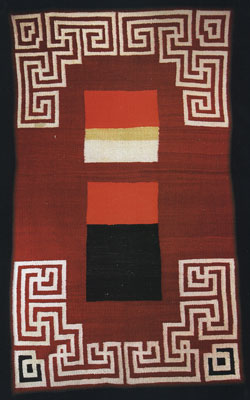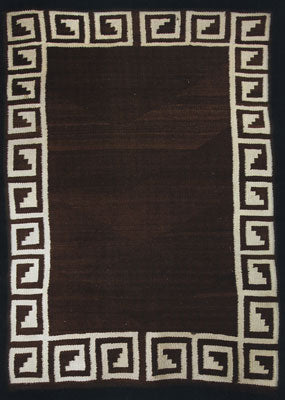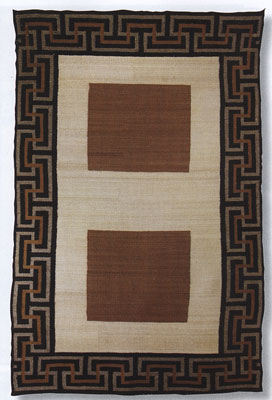Navajo Saddle Blankets 1870-1930, Western Art Collector
By Medicine Man Gallery on

Navajo Saddle Blankets 1870-1930s
Reproduced courtesy of Western Art Collector Magazine, July 2009

Navajo "WP Rogers" Pictorial Double Saddle Blanket, c. 1925, 31" x 45"
For over three centuries the Navajo have been weaving blankets, and those crafted during the last 100 years are known as saddle blankets. The earliest saddle blankets were created in the 1870s and they come in a variety of sizes, colors and thickness.
As a leader in Navajo textiles and pueblo pottery, Mark Sublette Medicine Man Gallery offers one of the largest inventories of Native American art and jewelry for sale in the country. Gallery owner Dr. Mark Sublette, an expert in Navajo weavings, has spent over a decade acquiring a collection of weavings that will be on show and for sale at the gallery’s Santa Fe location from July through September.

Navajo Double Saddle Blanket, c. 1920, 58" x 33"
“This will be the largest saddle blanket show and sale of its kind and will include rare examples from the late 1800s,” says Sublette. “I believe this show is a rare opportunity to see numerous stellar historic Navajo saddle blankets in a single-owner collection, which would be hard to duplicate today.”
Titled Navajo Saddle Blankets 1870-1930s, this collection reflects the vast and innovative designs of the golden era of Navajo saddle blankets. From natural handspun churro wool to Germantown, Navajo saddle blanket design influenced American and European modern artists of the early-to mid 20th century.

Navajo Double Saddle Blanket, c. 1900, 50" x 34"
“The organic nature of historic Navajo weavings has always fascinated me. The fact an artist can work for over a year on a textile without any preconceived drawing, all coming from the weaver’s soul and often under trying conditions, I find remarkable,” says Sublette. “Imagine weaving outside in the 20s in the Southwest desert with little amenities and relying primarily on your skill at weaving and raising sheep to help support your family. Sitting at a homemade loom hour after hour under strenuous conditions and still being able to make a remarkable piece of art. These Dine weavers, for me, are the definition of what being an artist is all about.”
This one-time show reflects Sublette’s own aesthetics in Navajo weavings, many which are simple in design.
“It’s the simplicity that gives them their depth of expression,” he adds. “This same concept of color and composition is what many find so compelling in the contemporary art scene.”
Sublette began collecting the blankets for the shear enjoyment they brought him. He amassed such an array of quality textiles by actively seeking pieces from collectors, estates, and even other dealers.

Navajo Double Saddle Blanket, c. 1920, 49" x 32"
“It became a hunt, as it does for most collectors, to find stellar examples. Once the word was out I was looking for exceptional saddle blankets, the textiles seemed to find me,” says Sublette. “Finding examples that qualified as outstanding became difficult after the core group was put together, though they are still out there.”
Among the highlights of this sale is a double saddle blanket with the initials W.P. Rogers that was commissioned for actor-humorist Will Rogers by his wife. Rogers, who knew his way around a horse, must have appreciated the beauty a great saddle blanket added to his favorite mount.
“It’s a great example of the type of people who were interested in these pieces,” says Sublette.
Many of the artists from the modern and pop movement either collected Navajo weavings or recognized their unique design features, adds Sublette. For instance, minimalist artist Donald Judd, whose abstract sculptures bring millions, collected Navajo weavings.
“One has to wonder if their geometric designs had some influence on his own development as an artist,” he says. “Artists like Warhol also saw the uniqueness of this truly American art form and actively collected them. Today it’s hard to visit a Ralph Lauren store without seeing the essences of what Navajo blankets have brought to the world of fashion. Great design translates over time and cultures, and the Navajo aesthetics fit the bill.”

Navajo Double Saddle Blanket, .c 1920, 53" x 34.5"